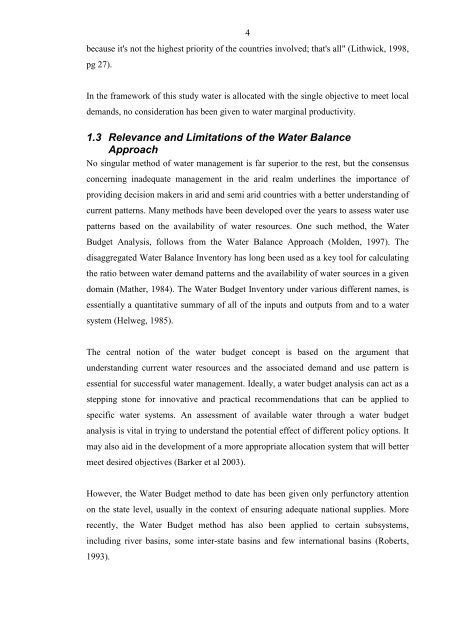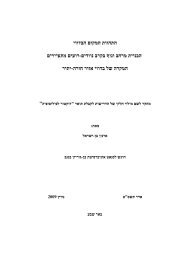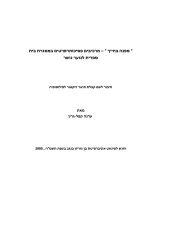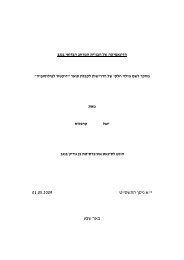Ben-Gurion University of the Negev Jacob Blaustein Institutes for ...
Ben-Gurion University of the Negev Jacob Blaustein Institutes for ...
Ben-Gurion University of the Negev Jacob Blaustein Institutes for ...
You also want an ePaper? Increase the reach of your titles
YUMPU automatically turns print PDFs into web optimized ePapers that Google loves.
4<br />
because it's not <strong>the</strong> highest priority <strong>of</strong> <strong>the</strong> countries involved; that's all" (Lithwick, 1998,<br />
pg 27).<br />
In <strong>the</strong> framework <strong>of</strong> this study water is allocated with <strong>the</strong> single objective to meet local<br />
demands, no consideration has been given to water marginal productivity.<br />
1.3 Relevance and Limitations <strong>of</strong> <strong>the</strong> Water Balance<br />
Approach<br />
No singular method <strong>of</strong> water management is far superior to <strong>the</strong> rest, but <strong>the</strong> consensus<br />
concerning inadequate management in <strong>the</strong> arid realm underlines <strong>the</strong> importance <strong>of</strong><br />
providing decision makers in arid and semi arid countries with a better understanding <strong>of</strong><br />
current patterns. Many methods have been developed over <strong>the</strong> years to assess water use<br />
patterns based on <strong>the</strong> availability <strong>of</strong> water resources. One such method, <strong>the</strong> Water<br />
Budget Analysis, follows from <strong>the</strong> Water Balance Approach (Molden, 1997). The<br />
disaggregated Water Balance Inventory has long been used as a key tool <strong>for</strong> calculating<br />
<strong>the</strong> ratio between water demand patterns and <strong>the</strong> availability <strong>of</strong> water sources in a given<br />
domain (Ma<strong>the</strong>r, 1984). The Water Budget Inventory under various different names, is<br />
essentially a quantitative summary <strong>of</strong> all <strong>of</strong> <strong>the</strong> inputs and outputs from and to a water<br />
system (Helweg, 1985).<br />
The central notion <strong>of</strong> <strong>the</strong> water budget concept is based on <strong>the</strong> argument that<br />
understanding current water resources and <strong>the</strong> associated demand and use pattern is<br />
essential <strong>for</strong> successful water management. Ideally, a water budget analysis can act as a<br />
stepping stone <strong>for</strong> innovative and practical recommendations that can be applied to<br />
specific water systems. An assessment <strong>of</strong> available water through a water budget<br />
analysis is vital in trying to understand <strong>the</strong> potential effect <strong>of</strong> different policy options. It<br />
may also aid in <strong>the</strong> development <strong>of</strong> a more appropriate allocation system that will better<br />
meet desired objectives (Barker et al 2003).<br />
However, <strong>the</strong> Water Budget method to date has been given only perfunctory attention<br />
on <strong>the</strong> state level, usually in <strong>the</strong> context <strong>of</strong> ensuring adequate national supplies. More<br />
recently, <strong>the</strong> Water Budget method has also been applied to certain subsystems,<br />
including river basins, some inter-state basins and few international basins (Roberts,<br />
1993).
















